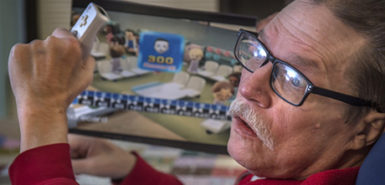
When doctors diagnosed Tom Pendergrass with Parkinson’s disease in 2007, he didn’t let it stop him.
The Stevensville, Michigan, retiree enjoyed golfing with his buddies, and he even took up a new hobby: Making scale models of local icons such as the North Pier, the St. Joseph lighthouse and area fishing boats.
Today, you can still see his handcrafted reproductions on display at the Orchards Mall in Benton Harbor.
But he won’t be adding more models to the collection.
A few years ago, the disease forced him to give up woodworking. The 81-year-old’s battle with tremors and rigidity became too much, and he began to have trouble walking and eating.
He experienced hallucinations, too, triggered by high doses of Sinemet, a combination of carbidopa and levodopa, often used to control Parkinson’s symptoms.
Desperate for improvement, Tom and his wife, Gerry, met in summer 2015 with Spectrum Health Medical Group neurologist Ashok Sriram, MD, MS, who recommended he try a dopamine pump.
“As Parkinson’s disease advances, we see symptom fluctuations as the patient swings between ‘on times’ when the medication is working, and ‘off times’ when the drug wears off before the next dose. As the off time becomes worse, it impacts the patient’s quality of life,” said Dr. Sriram, a movement disorders specialist. “The dopamine pump continuously infuses the medication to keep the blood level fairly constant … improving the quality of life.”
While patients in Europe have been using the dopamine pump system for more than a decade, the FDA didn’t approve it for the U.S. market until last year.
Tom received the pump around Labor Day weekend.
It delivers Duopa, a gel version of his medication, through a tube inserted into a permanent port in his abdomen. The dose is controlled with buttons on a box—like an oversized TV remote control—he wears at his waistline.
After just a few days spent adjusting the medication level, Tom noticed a huge improvement.
He still has ups and downs, but the pump helps him get more pleasure out of life. He’s eating better, he’s controlling his symptoms, and he’s getting out and about.
“It gave us hope,” Gerry said. “Before, his rigidity was really bad. He would freeze up and couldn’t move, and sometimes he would stumble or fall. That doesn’t happen anymore.”
Even his handwriting has improved.
Gerry recalled Mother’s Day a few years ago, when Tom gave her a card she couldn’t even read—it was simply illegible.
These days, his writing is readable once again.
A big upside to the dopamine pump: “I can easily give him an extra boost of medicine if he has trouble with tremors,” Gerry said. “Even if we’re out someplace and he starts feeling bad, I can hit the pump and he feels better within five minutes.”
According to Dr. Sriram, patients must have a good social support system to qualify for this treatment.
“The pump needs attention every day,” Dr. Sriram said. “Someone must be there to insert new medication cartridges, discard old ones and flush the pump.”
At the Pendergrass household, Gerry connects the pump for Tom at 6 a.m. daily and then disconnects it at bedtime. She is generally the one who keeps the medication flowing, too, although she doesn’t need to be with him 24/7.
“I can stay by myself, and she shows me what button to push if I need more medication,” Tom said. “It’s easy to use.”
 /a>
/a>
 /a>
/a>
 /a>
/a>
Great news for Tom and his family. I graduated with Tom from high school and glad to hear about this new treatment for him.
I believed a positive attitude and a good exercise program are essential in your arsenal of tools! Attitude is everything.